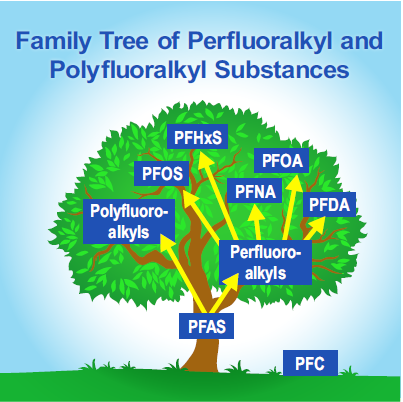PFOS and Drinking Water
PFOAs are part of a family of chemicals known as Perfluorinated Compounds (PFCs). PFCs are man-made compounds and not naturally found in the environment. This group includes Perfluorooctanoic Acid (PFOA) and Perfluorooctanesulfonic Acid (PFOS) as well as numerous other polyfluoralkyl substances.
These materials have been used for many years in firefighting foams, coatings, cleaning products, lubricants, microwave popcorn coatings, fast food containers, non-stick cookware, plastic food storage containers, cosmetics, and personal care products.
Drinking water can be a source of exposure in communities where these chemicals have contaminated water supplies. Such contamination is typically localized and associated with a specific facility, for example:
- An industrial facility where PFAS were produced or used to manufacture other products, or
- Locations where firefighting foam was used such as oil refineries, airfields or other training facilities for firefighters.
Research involving humans suggests high levels of certain PFAS may lead to the following:

These unregulated compounds are not included on either the US-EPA's or PA-DEP's Safe Drinking Water Act Primary or Secondary listing of contaminants. However, the EPA has established, a US-EPA Health Advisory Level of 70 ppt (parts per trillion) for PFOA + PFOS to ensure protection of the public.
A Health Advisor Level is set to provide Americans, including our most sensitive populations children, pregnant women, and the immunocompromised with a margin of protection from a lifetime of exposure to PFOA and PFOS in drinking the water over their lifetime.
Links
- EPA - Per- and Polyfluoroalkyl Substances (PFAS)
- The Pennsylvania Department of Environmental Protection (PA-DEP)
- https://papfas.rti.org/
North Wales Water Authority & Ambler Water Reports
North Wales Water Authority and Ambler Water have monitored and reported the results to the US Environmental Protection Agency (US-EPA) and the Pennsylvania Department of Environmental Protection (PA-DEP).
- North Wales Water Authority reports PFOS information to the public as part of their water quality reports.
- North Wales Water Authority Additional Reporting
- Ambler Water reports PFOS information
Agency for Toxic Substances and Disease Registry
CDC/ATSDR recognizes that exposure to high levels of PFAS may impact the immune system. There is evidence from human and animal studies that PFAS exposure may reduce antibody responses to vaccines (Grandjean et al., 2017, Looker et al., 2014), and may reduce infectious disease resistance (NTP, 2016). Because COVID-19 is a new public health concern, there is still much we don’t know. More research is needed to understand how PFAS exposure may affect illness from COVID-19.
